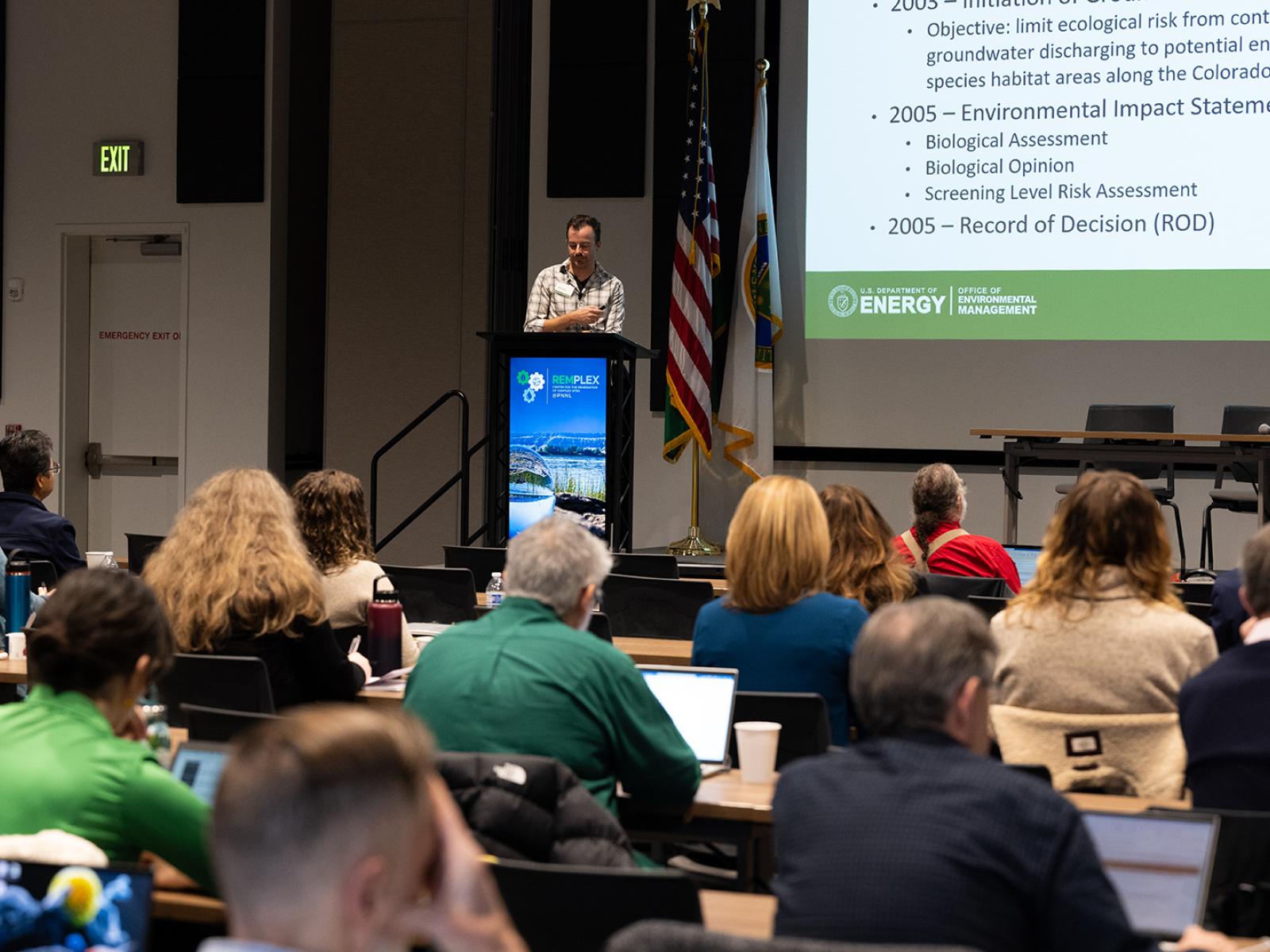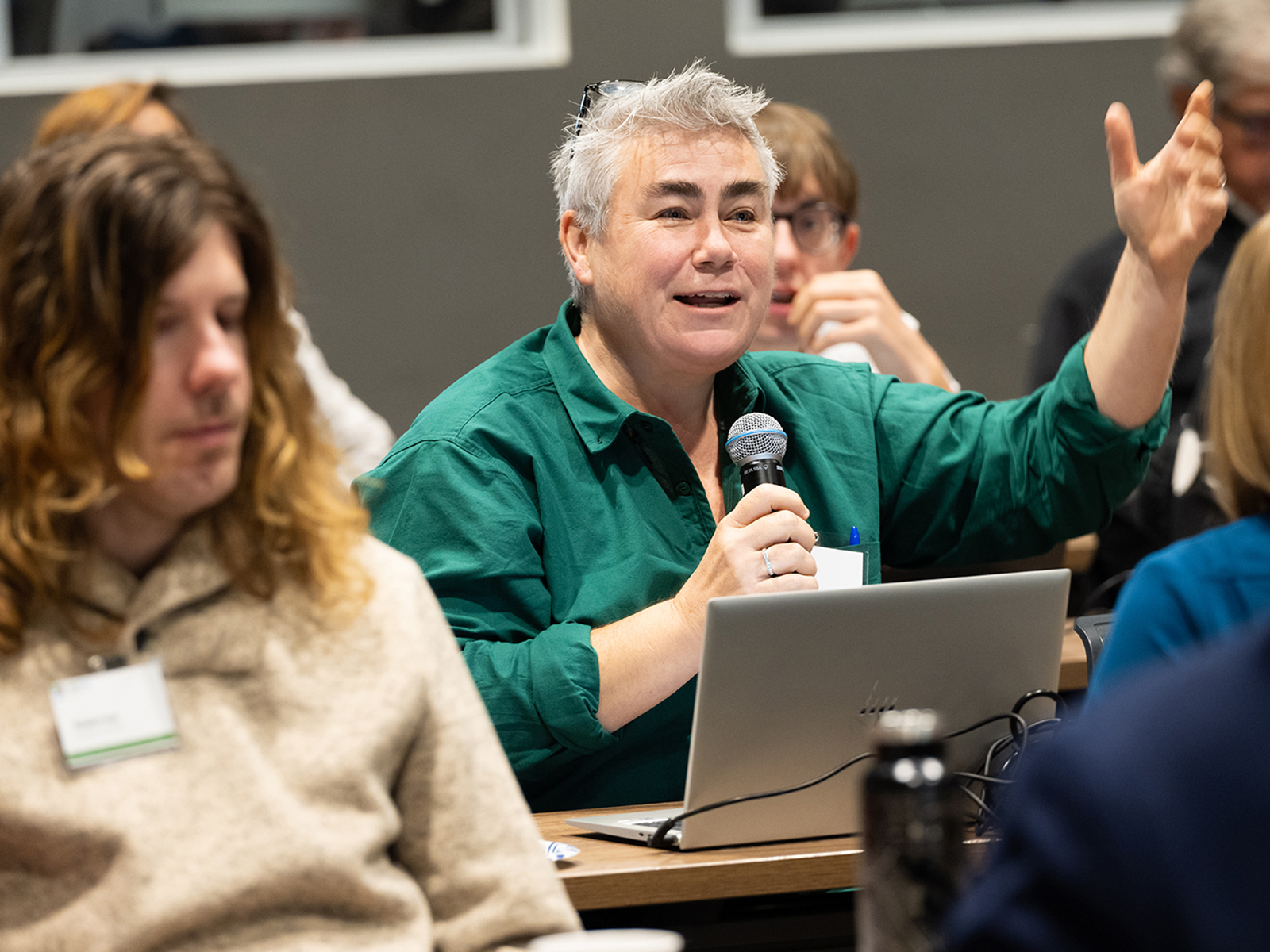Environmental Remediation Experts Gather for RemPlex Global Summit
PNNL’s Center for the Remediation of Complex Sites convened attendees from around the world to discuss challenges associated with environmental contamination

The RemPlex Global Summit on Environmental Remediation was held in November 2023 at Pacific Northwest National Laboratory in Richland, Washington State, USA. Nearly 150 people attended. Here, James Ritchey with North Wind Portage presents the Moab case study. Video recordings of the entire summit, along with more than 100 presentations, are available on the summit website.
(Photo by Andrea Starr | Pacific Northwest National Laboratory)
Use of drones to conduct radiological surveys from the sky, contamination monitoring 200-feet underground, and analysis of environmental data with artificial intelligence tools, were among the captivating emerging technology themes discussed at the Global Summit on Environmental Remediation, which addressed a breadth of challenges, barriers, and innovative solutions for successful remediation and long-term stewardship of contaminated sites worldwide.
The Center for the Remediation of Complex Sites (RemPlex) at Pacific Northwest National Laboratory (PNNL) in Richland, Washington, hosted its second Global Summit on Environmental Remediation in cooperation with the International Atomic Energy Agency (IAEA). The RemPlex 2023 Summit held in November brought together nearly 150 participants representing over 20 nations. Video recordings of the entire event, along with more than 100 presentations, are available on the summit website.
“Meetings of the caliber of RemPlex are extremely useful to share good practices, reveal innovative approaches and examine challenges to be dealt with in the scope of environmental remediation,” said Horst Monken-Fernandes, IAEA environmental remediation specialist. “They lead to the formation of partnerships amongst participants and indicate ways the IAEA can explore to support its Member States, which in their turn may take advantage of getting a broader understanding and consequently benefit from the wide range of activities that are developed by the IAEA.”
RemPlex was formed in 2019 to foster technical leadership, collaborative research, and professional development with the intent of facilitating science-based, cost-effective remediation of complex sites. Additionally, PNNL and the IAEA have a partnership agreement to collaborate on technical assistance to IAEA Member States to help them incorporate advancements into their decommissioning and remediation projects.
“We define complex sites as sites with multiple sources of contamination, multiple contaminants, comingled plumes, and complex geology,” said Tom Brouns, PNNL’s Environmental Management Sector manager and director of RemPlex.
The Global Summit is one way in which RemPlex convenes researchers, policy makers and regulators, site operators, and industry partners internationally over the common mission of environmental remediation.
Each day opened with a case study, starting locally with an in-depth look at the Hanford Site, which is adjacent to PNNL. The session focused on lessons learned from Hanford Site cleanup and sparked conversation about new technologies and opportunities including the use of real-time 4-D subsurface geophysical imaging and process monitoring for groundwater contamination.
Naomi Jaschke, director of the Soil and Groundwater Division with the Department of Energy (DOE) Richland Operations Office, offered insight into how the technology was used to alter a groundwater remediation strategy at the Hanford Site to make it more effective.
To bolster the case study overview, summit attendees were invited to tour the Manhattan Project National Historical Park at Hanford, including the B Reactor.
Additional case studies evaluated management of the former uranium ore processing Moab project in Utah, and then moved internationally to analyze legacy waste cleanup at nuclear sites in the United Kingdom, including Great Britain and Scotland. Juliet Long, chief strategist for site decommissioning and remediation at Nuclear Decommissioning Authority in UK, led the case study.
“It’s been a lifelong goal to come and see Hanford. It’s really helped connect all the dots for me,” Long said. “Our role is looking at how to transform sites and do much of what you do, but maybe not at that scale.”

The conversations and connection between speakers, attendees, and site stewards served as a reminder of the significance of global forums and its power to actively drive expertise and knowledge sharing. As complex sites change over time and technologies evolves, research and development based collaborations continue to be important.
“Thank you for reaching out and bringing us into this conversation,” Long said. “We need imagination, and with science and opportunity we unlock potential. We are here as one family.”
In a presentation by Rod Rimando, acting director for the DOE Office of Technology Development within the Office of Environmental Management, he shared, “We need to continue to, and aggressively advocate, for scientific discovery. We need to keep pace with technological advancement—not just with the state-of-the-art, but with future state-of-the-art—and we need to embrace new concepts, advanced tools, complimentary capabilities, and baseline alternatives.”
The summit organized nine technical sessions and a general poster session, examining a broad spectrum of topics to advance environmental remediation. The best presentation from each session was recognized with an award, listed as below:
- Session 1, Environmental Management and Stewardship Innovations, Hilary Emerson, PNNL, “Phosphate Amendments for Treatment of U and Tc-00 in the Hanford Site’s Central Plateau.”
- Session 2, Artificial Intelligence/Machine Learning-Empowered Digitization of Environmental Systems, Xuehang Song, PNNL, “Leveraging a Data-Driven Approach for Optimizing Pump-and-Treat Well Network Operations.”
- Session 3, Innovative Characterization and Monitoring Technologies and Methodologies, Léa Lévy, Lund University, “Building Reliable Groundwater Transport Models at Contaminated Sites Using Cross-Borehole Electrical Monitoring.”
- Session 4, Emerging Remediation Technologies, Callum Robinson, The University of Manchester, “In Situ Biomineralisation for Sellafield Groundwater Radionuclide Remediation.”
- Session 5, Environmental Data Management, Analysis, and Visualization, Tollef Winslow, Central Plateau Cleanup Company, “Geoframework Models: A Force Multiplier.”
- Session 6, Critical Minerals (including Rare Earth Elements): the Promise, Challenge, and Environmental Risk, Chandra Tummala, Wayne State University, “Recovering Critical Minerals from the Phosphate Fertilizers Could Reduce their Accumulated Concentration Levels in the Agricultural Soils.”
- Session 7, Ensuring Sustainability and Resiliency of Remediation Projects, Federica Panzarella, KU Leuven and Belgian Nuclear Research Centre – SCK CEN, “Site Remediation and Social Sustainability: A Case Study.”
- Session 8, Multiscale Modeling in Porous Media: Theory to Applications, Fred Zhang, INTERA Inc., “Modeling Evapotranspiration and Soil-Moisture Flow of a Modified RCRA Subtitle C Surface Barrier.”
- Session 9, Autonomous Measurements and Remote Sensing Across Scales, Luke Placzek, PNNL, “Leveraging Aerial Robotics for Environmental Discovery.”
- Poster Session, Rahima Tufail, Wayne State University, “Functionality of Coal Fly Ash in Mortars After Rare Earth Element Recovery.”
“As we move forward, we’re asking, how do we keep dialogue, communication, and collaboration going and what role can RemPlex play in that,” Brouns said. “The Global Summit is a key platform, and we are also committed to exploring additional approaches to further this important international collaboration in cleanup.”
These efforts include the RemPlex Seminar Series, with the first 2024 presentation scheduled for February 20 about a pre-screening tool for pump-and-treat performance management.
Sign up for the RemPlex newsletter to be notified about upcoming seminars and other opportunities to connect and learn, or contact remplex@pnnl.gov to explore collaborating or to suggest topics for future RemPlex events.
Published: February 15, 2024